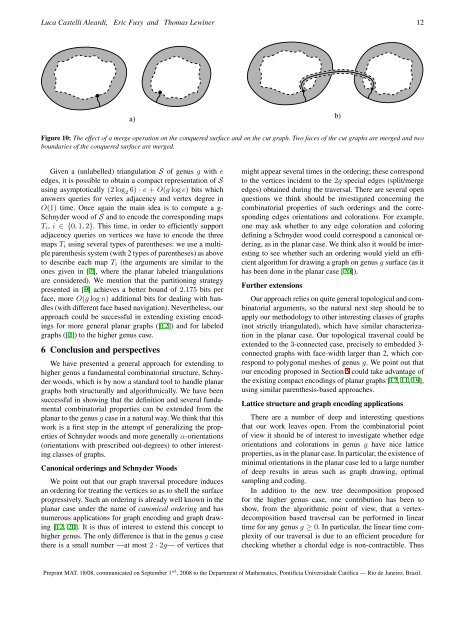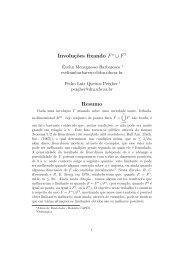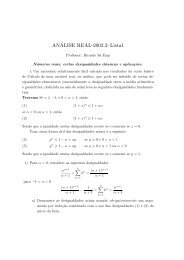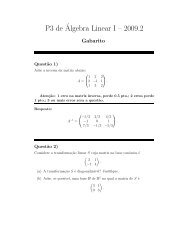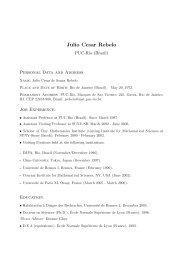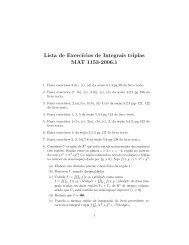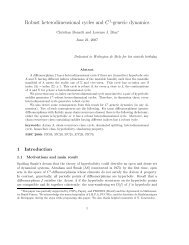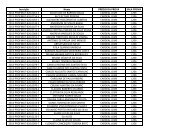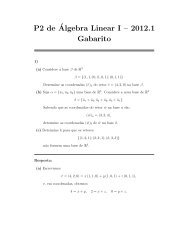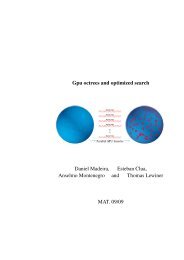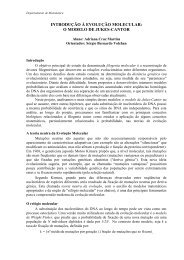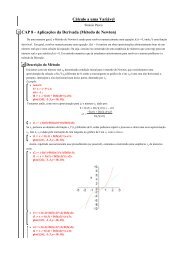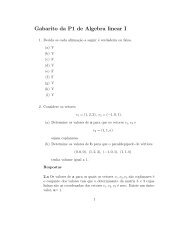Schnyder woods for higher genus triangulated surfaces with ...
Schnyder woods for higher genus triangulated surfaces with ...
Schnyder woods for higher genus triangulated surfaces with ...
You also want an ePaper? Increase the reach of your titles
YUMPU automatically turns print PDFs into web optimized ePapers that Google loves.
Luca Castelli Aleardi, Eric Fusy and Thomas Lewiner 12<br />
a)<br />
b)<br />
Figure 10: The effect of a merge operation on the conquered surface and on the cut graph. Two faces of the cut graphs are merged and two<br />
boundaries of the conquered surface are merged.<br />
Given a (unlabelled) triangulation S of <strong>genus</strong> g <strong>with</strong> e<br />
edges, it is possible to obtain a compact representation of S<br />
using asymptotically (2 log 2 6) · e + O(g log e) bits which<br />
answers queries <strong>for</strong> vertex adjacency and vertex degree in<br />
O(1) time. Once again the main idea is to compute a g-<br />
<strong>Schnyder</strong> wood of S and to encode the corresponding maps<br />
T i , i ∈{0, 1, 2}. This time, in order to efficiently support<br />
adjacency queries on vertices we have to encode the three<br />
maps T i using several types of parentheses: we use a multiple<br />
parenthesis system (<strong>with</strong> 2 types of parentheses) as above<br />
to describe each map T i (the arguments are similar to the<br />
ones given in [2], where the planar labeled triangulations<br />
are considered). We mention that the partitioning strategy<br />
presented in [9] achieves a better bound of 2.175 bits per<br />
face, more O(g log n) additional bits <strong>for</strong> dealing <strong>with</strong> handles<br />
(<strong>with</strong> different face based navigation). Nevertheless, our<br />
approach could be successful in extending existing encodings<br />
<strong>for</strong> more general planar graphs ([12]) and <strong>for</strong> labeled<br />
graphs ([2]) to the <strong>higher</strong> <strong>genus</strong> case.<br />
6 Conclusion and perspectives<br />
We have presented a general approach <strong>for</strong> extending to<br />
<strong>higher</strong> <strong>genus</strong> a fundamental combinatorial structure, <strong>Schnyder</strong><br />
<strong>woods</strong>, which is by now a standard tool to handle planar<br />
graphs both structurally and algorithmically. We have been<br />
successful in showing that the definition and several fundamental<br />
combinatorial properties can be extended from the<br />
planar to the <strong>genus</strong> g case in a natural way. We think that this<br />
work is a first step in the attempt of generalizing the properties<br />
of <strong>Schnyder</strong> <strong>woods</strong> and more generally α-orientations<br />
(orientations <strong>with</strong> prescribed out-degrees) to other interesting<br />
classes of graphs.<br />
Canonical orderings and <strong>Schnyder</strong> Woods<br />
We point out that our graph traversal procedure induces<br />
an ordering <strong>for</strong> treating the vertices so as to shell the surface<br />
progressively. Such an ordering is already well known in the<br />
planar case under the name of canonical ordering and has<br />
numerous applications <strong>for</strong> graph encoding and graph drawing<br />
[12, 20]. It is thus of interest to extend this concept to<br />
<strong>higher</strong> <strong>genus</strong>. The only difference is that in the <strong>genus</strong> g case<br />
there is a small number —at most 2 · 2g— of vertices that<br />
might appear several times in the ordering; these correspond<br />
to the vertices incident to the 2g special edges (split/merge<br />
edges) obtained during the traversal. There are several open<br />
questions we think should be investigated concerning the<br />
combinatorial properties of such orderings and the corresponding<br />
edges orientations and colorations. For example,<br />
one may ask whether to any edge coloration and coloring<br />
defining a <strong>Schnyder</strong> wood could correspond a canonical ordering,<br />
as in the planar case. We think also it would be interesting<br />
to see whether such an ordering would yield an efficient<br />
algorithm <strong>for</strong> drawing a graph on <strong>genus</strong> g surface (as it<br />
has been done in the planar case [20]).<br />
Further extensions<br />
Our approach relies on quite general topological and combinatorial<br />
arguments, so the natural next step should be to<br />
apply our methodology to other interesting classes of graphs<br />
(not strictly <strong>triangulated</strong>), which have similar characterization<br />
in the planar case. Our topological traversal could be<br />
extended to the 3-connected case, precisely to embedded 3-<br />
connected graphs <strong>with</strong> face-width larger than 2, which correspond<br />
to polygonal meshes of <strong>genus</strong> g. We point out that<br />
our encoding proposed in Section 5 could take advantage of<br />
the existing compact encodings of planar graphs [12, 11, 19],<br />
using similar parenthesis-based approaches.<br />
Lattice structure and graph encoding applications<br />
There are a number of deep and interesting questions<br />
that our work leaves open. From the combinatorial point<br />
of view it should be of interest to investigate whether edge<br />
orientations and colorations in <strong>genus</strong> g have nice lattice<br />
properties, as in the planar case. In particular, the existence of<br />
minimal orientations in the planar case led to a large number<br />
of deep results in areas such as graph drawing, optimal<br />
sampling and coding.<br />
In addition to the new tree decomposition proposed<br />
<strong>for</strong> the <strong>higher</strong> <strong>genus</strong> case, one contribution has been to<br />
show, from the algorithmic point of view, that a vertexdecomposition<br />
based traversal can be per<strong>for</strong>med in linear<br />
time <strong>for</strong> any <strong>genus</strong> g ≥ 0. In particular, the linear time complexity<br />
of our traversal is due to an efficient procedure <strong>for</strong><br />
checking whether a chordal edge is non-contractible. Thus<br />
Preprint MAT. 18/08, communicated on September 1 st , 2008 to the Department of Mathematics, Pontifícia Universidade Católica — Rio de Janeiro, Brazil.


